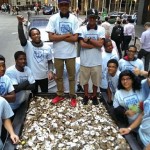 Citizen science has been a topic I’ve touched on numerous times on this blog, and the scale of such projects has been growing in recent years. For instance, at the recent BETT show I was given a tour of the new BBC led micro.bit project, which aims to give away 1 million kits to encourage school children to code and develop electronic devices.
Citizen science has been a topic I’ve touched on numerous times on this blog, and the scale of such projects has been growing in recent years. For instance, at the recent BETT show I was given a tour of the new BBC led micro.bit project, which aims to give away 1 million kits to encourage school children to code and develop electronic devices.
In future, the consortium hope to tap into this army of coders to perform citizen science in a range of areas through the Wellcome Trust. It’s aim is to allow youngsters to participate in real projects whilst they learn.
Combining learning with doing
A great example of this is the STEM Collaboratory at Pace University that allows users to engage in real scientific research whilst they develop their skills in areas such as water quality monitoring and enquiry based research techniques.
In addition to doing invaluable work, such projects also play a fundamental role in widening participation, and encouraging the suggestion that science is something we should all take an interest in.
For instance, the Billion Oyster Project (BOP), aims to restore one billion live oysters to the New York Harbor. The project, which was launched 10 years ago, has recruited some 100,000 school children through its STEM education program, with 11 million oysters restored to the area.
The Pace team have recently been awarded a $5 million grant from the National Science Foundation (NSF), and the signs are good that it is making an impact already.
“Teachers have displayed a stronger interest in teaching enquiry-based lessons through citizen science and environmental restoration,” the team say. “Students continue to exhibit excitement through active participation in the field and have taken ownership of the learning process inside the classroom as well in the field – the field being the New York Harbor. This engagement stimulates an interest in the STEM content areas.”
Eventually, they hope to achieve three core goals:
- to improve the quality and effectiveness of STEM teaching
- to enhance the knowledge and teaching skills of teachers
- to develop the knowledge of and interest in STEM in students
The project is particularly keen to work with students from low-income neigborhoods that are traditionally under-represented in STEM fields. To support this, the team are developing lesson plans that are related to the harbor restoration work.
Ultimately, the team hope that their model can be replicated in other ways, in other school districts both inside the US and overseas. They hope to eventually offer resources and support to help other areas setup their own similar projects.
Projects such as these allow students to not just see science as a theoretical activity but to actually get their hands dirty on projects that make a real difference.
Hopefully as citizen science becomes more widespread, we will see it form an ever greater part of the school curriculum.
I would have loved this growing up. Learning whilst actually contributing to cool projects at the same time. That would have been awesome!